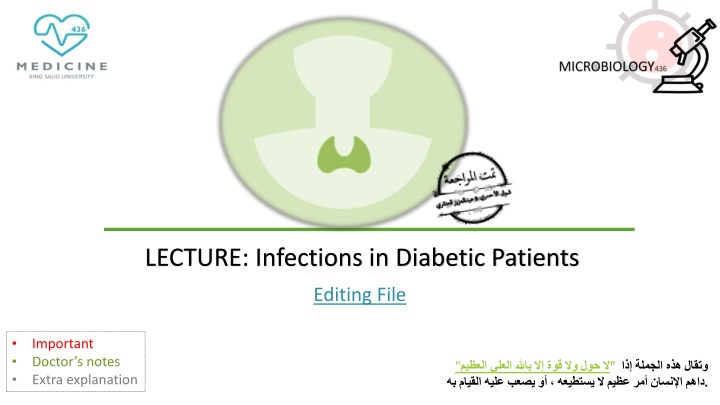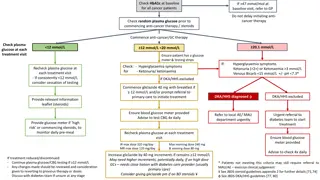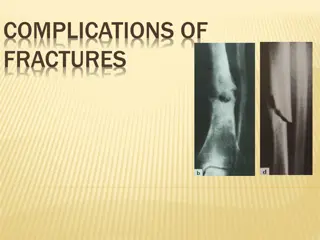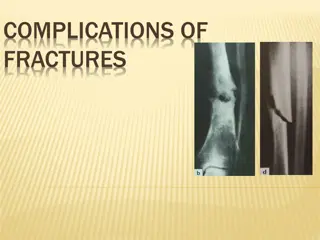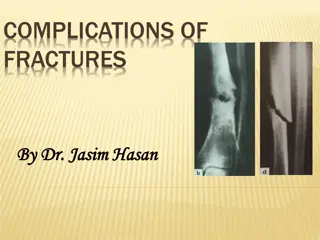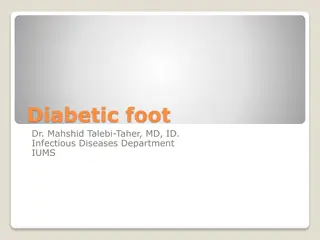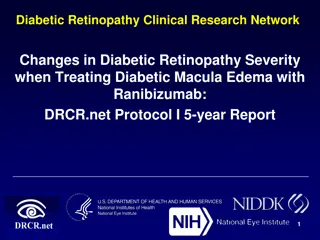Infections in Diabetic Patients: Understanding Risks and Complications
Diabetic patients are at increased risk of infections due to both host-related and organism-specific factors. Learn about the epidemiology, complications, and management of infections in diabetic patients. Discover the clinical presentations and diagnostic approaches for different types of infections.
Download Presentation

Please find below an Image/Link to download the presentation.
The content on the website is provided AS IS for your information and personal use only. It may not be sold, licensed, or shared on other websites without obtaining consent from the author.If you encounter any issues during the download, it is possible that the publisher has removed the file from their server.
You are allowed to download the files provided on this website for personal or commercial use, subject to the condition that they are used lawfully. All files are the property of their respective owners.
The content on the website is provided AS IS for your information and personal use only. It may not be sold, licensed, or shared on other websites without obtaining consent from the author.
E N D
Presentation Transcript
LECTURE: Infections in Diabetic Patients Editing File Important Doctor s notes Extra explanation " " .
OBJECTIVES: Definition Epidemiology Risk factors Complications Clinical presentation Diagnostic approaches Management and Prevention of infections in diabetic patients It is very important to know the clinical presentation for each type of infection.
Introduction: Introduction: Unlike healthy patients, diabetics are more susceptible to infections due to both host-related and organism-specific factors. Nearly half of all diabetics have visited the hospital (outpatient), or have been hospitalized (inpatient) due to infections. Infections can increase the morbidity and mortality in diabetic patients. Complications of diabetes: Diabetic Nephropathy, Retinopathy, Neuropathy, Atherosclerosis, Endothelial abnormalities and Gangrene. The predisposing factors for diabetes are genetic factors and environmental factors Why diabetic patients are at increased risk to have infections? because of 2 main factors : organism specific factors - host related factors (next slide) : Organism specific factors Candida species Rhizopus species* glucose inducible proteins promote adhesion of C.albicans to buccal or vaginal epithelium which in turn, impairs phagocytosis, giving the organism advantage over the host. Not common in healthy person , it s affecting immune defect host like DM ketoacidosis allow Rhizopus spp. which cause Mucormycosis (Zygomycosis) to thrive in high glucose acidic conditions . Patient present with diabetic ketoacidosis and severe headache around his eye second most severe infection after Necrotising Fasciitis. It is acute, devastating and hard to treat. * First t the patient will have sinusitis >> go to the brain >> headache >> ketoacidosis >>coma (imp even in USMEL)
Host related factors: Host related factors: imp slide imp slide Result in local tissue ischemia that enhances the growth of microaerophilic and anaerobic organisms while depressing the O2 dependent bactericidal functions of leukocytes. There may be also impairment of the local inflammatory response and absorption of antibiotics. Vascular insufficiency Sensory peripheral neuropathy Minor local trauma may result in skin ulcers, which leads to diabetic foot infections. Diabetic patients may develop urinary retention and stasis, hence, predisposes UTIs. Autonomic neuropathy Depressed Neutrophil function. Affected adherence to the endothelium. Decreased chemotaxis and phagocytosis. Compromised intracellular bactericidal activity. Opsonization. Depressed cell mediated immunity. Immune defects (both humoral and non- humoral will affected)
Host related factors: Host related factors: imp slide imp slide Diabetics on insulin have asymptomatic nasal and skin colonization with Staphylococcus Aureus, particularly MRSA (Methicillin-Resistant Staphylococcus Aureus). Colonization predisposes to skin infection and transient bacteraemia which may result in distal sites infection such as damaged muscle. In type 2 diabetes, mucosal colonization with Candida Albicans is common. Vulvovaginitis caused by Non-Albicans Candida species is common in patients with poor glycemic control. Increased skin and mucosal colonization Associated with postoperative hyperglycemia which is related to deleterious effect on chemotaxis, adherence, and phagocytosis by granulocytes. Surgical site infectiona Metabolic derangements in diabetes may facilitate infection especially candidiasis . It also plays a role in UTIs. Hyperglycemia Common infections in diabetic patients Common infections in diabetic patients Upper & lower respiratory tract infections Periodontal infections Genitourinary infections Abdominal infections Skin and soft tissue & diabetic foot infections
Different infections in diabetic patients: Different infections in diabetic patients: diabetic patient gets frequent respiratory tract infections like: flue ,pneumonia ,etc. and this is common but the srious infection that is common is the invasive malignant otitis externa Upper respiratory tract infections Invasive (Malignant) Otitis externa * uncommon but potentially life threatening. Rhinocerebral Mucormycosis A life threatening fungal infection Cause Pseudomonas Aeruginosa Cause Risk factor Rhizopus, Absidia and Mucor species MOA Slowly invades from the external canal of the ear into adjacent soft tissues, mastoid and temporal bones, and eventually spreads across the base of the skull. Diabetic Ketoacidosis always accompany mucormycosis http://t3.gstatic.com/images?q=tbn:ANd9GcTDbAN0n_7J8Oe1gCzguh3c90OU7J1I4aD7eFXMJYdkNEvscGT9wb7VQo6Q Clinical Severe pain, otorrhea (discharge from ear ),hearing loss, intense cellulitis and edema of the ear canal. Clinical May be Intranasal black eschars or necrotic turbinate, facial or ocular pain, nasal stuffiness, generalized malaise, fever. Diagnose CT or MRI to define the extent of bone destruction. Treatment Surgical debridement. IV anti-pseudomonals (ceftazidme gentamicin piperacillin ). Diagnose Biopsy of the necrotic tissue + Direct smear examination for hyphae Surgical debridement. Prolonged IV Amphotericin B. Treatment * otitis externa is usually outside and it is mild but when it serious it becomes malignant malignant because it invades deeper tissue-.
Different infections in diabetic patients: Different infections in diabetic patients: Continue Lower Respiratory Tract Infections Pneumonia and Influenza Diabetic patients are 4 times more likely to die from pneumonia or influenza than non-diabetic patients Gram positive bacteria: Staphylococcus Aureus (especially S.aureus after developing an influenza infection) and Streptococcus Pneumoniae. Gram negative bacteria: Enterobacteria and Legionella. Other organisms: Influenza Virus and Mycobacterium Tuberculosis Cause prevention Routine pneumococcal and influenza vaccination are recommended Abdominal infections Severe Fulminating Cholecystitis Cause Enteric Gram Negative Bacteria and Anaerobes. Complication Gall stone or Peritonitis may be present. Gas gangrene and perforation may occur. Treatment Cholecystectomy + Broad spectrum antibiotics.
Different infections in diabetic patients: Different infections in diabetic patients: Continue Genitourinary Infections Genitourinary Infections a) Asymptomatic Bacteriuria: > 10^5 bacteria/ml urine (common) Clinical : Symptoms, Signs, and duration of onset are similar to non-diabetics. Prevention : Screening is indicated for diabetic patients to treat asymptomatic bacteriuria. + treating blood sugar Types : Bilateral*: Diabetes predisposes to a more severe infection of the upper urinary tract. Emphysematous**: Exclusively present in diabetics (60%). Carries grave prognosis (30% fatal). b) Pyelonephritis : Kidney infection Bladder infection ( very dangerous in diabetic patients because 30% of the patients have upper UTI infections ) Cystitis :very common Clinical : Same as non-diabetics.. Incomplete bladder emptying especially in women and high incidence of unsuspected upper UTI. Cause : Gram positive: Group B Streptococcus*** (Streptococcus Agalactiae). Gram negative: Escherichia Coli gram negative rods Fungal: Candida Albicans not common in non-diabetic infection . *(exclusive to diabetic patients ) **microabscess in the kidney. So we have to be careful in case of diabetes for kidney because diabetic patient are already susceptible to nephropathy so any compression to kidney vessels (ex: by infection) will cause renal failure, and some will develop severe pyelonephritis. ***group B Streptococcus is very common in diabetic patient Diagnosis : Flank mass, crepitus, and CT scan shows gas in the renal tissues. Treatment : Supportive + IV antibiotics + Nephrectomy if needed.
Different infections in diabetic patients: Different infections in diabetic patients: Continue Skin and Soft Tissue Infections: Skin and Soft Tissue Infections: Risk Factors : imp sensory neuropathy with no pain perception. Atherosclerotic vascular disease. Hyperglycemia: >250 mg/dl. History of cellulitis, peripheral vascular diseases, tinea infection, and dry skin Organisms: Streptococcus pyogenes ( Group A Streptococcus (GAS) most common ) and S.aureus. CA-MRSA ( community acquired -MRSA) is of concern causes (77%) of skin and soft tissue infections . Necrotizing Fasciitis and Myositis : Deep life threatening infection of subcutaneous tissue with progressive destruction of fascia, fat, muscles, and bones . 10% of Necrotizing Fasciitis associated with GAS (Group A Streptococcus) (they re very virulent in diabetic patients) with or without Staphylococcus Aureus. Clostridium Fragilis (Gas producing gram positive bacilli) - Especially in Myositis. Anaerobes - Requires wound discharge. Causes : Clinically : imp Very sever pain of proportion of skin and anesthesia of overlying skin. Violaceous discoloration (purple) of skin that evolves into vesicles and bullae. Acute illness with painful induration of the limb especially the thigh, foot may be involved. Crepitus. Soft tissue gas seen in radiograph or CT scan . Treatment : Aggressive surgical debridement with wound discharge + IV antibiotics.
Different infections in diabetic patients: Different infections in diabetic patients: Continue Diabetic Foot :The most common and most important soft tissue in diabetic patients why? Peripheral neuropathy may lead to incidental trauma that goes unrecognized. Compromised microvascular circulation (ischemia) which limits the access of phagocytic cells to the site of infection. Poor concentration of antibiotics in the affected area. All these factors are important to develop the infection Can lead to amputation and death. Significance : Chronic Osteomyelitis. Gas Gangrene (due to Clostridium Perfringens).Amputation and death Complicated By Compromised local blood supply predisposing foot to infection, that is due to: Microvascular disease. Pressure from ill-fitting shoes. Trauma. Compromises local blood supply predisposing foot to infection. Ranges from superficial cellulitis to chronic osteomyelitis. Infection may be involving skin, bone or soft tissue or all Diabetic neuropathy may lead to incidental trauma that goes unrecognized. Sinus tract may be present. Spectrum ) ( Pathogenesis What is diabetic foot ? is a foot that exhibits any pathology results directly from diabetes mellitus or any complication of diabetes mellitus mainly peripheral neuropathy
Different infections in diabetic patients: Different infections in diabetic patients: Continue Vascular and neurological state examination. Radiology: Doppler ultrasonography - Transcutaneous oximetry - MR angiography. CT, MRI, or Gallium scan for soft tissue and bone. Exploration of ulcer to determine its depth and the presence of sinus tract. Deep specimens (tissues) for culture and susceptibility testing. Diagnosis o Control blood sugar and hydration. o Continuous evaluation of neuropathy and vasculopathy. Mild case: Debridement of necrotic tissue + Antibiotic according to the causative bacteria e.g. Cloxacillin, Cephradine, Clindamycin, TMP-SMX (for CA-MRSA), Aminoglycosides, Quinolones. Moderate to sever case: Hospitalization + IV antibiotics + Possible surgery (amputation). Is the cornerstone of diabetic foot care. It is multidisciplinary including family physician, social worker, home care nurse and specialist. Patient education about the control and complication of diabetes. Blood sugar should be controlled promptly (shift to insulin if oral hypoglycemic agents were not effective), weight reduction, a diet low in fat and cholesterol. Proper foot care, using protective footwear and pressure reduction. Self and family member examination of foot. Treatment Prevention
Organisms involved in diabetic foot infections Organisms involved in diabetic foot infections o Cellulitis: beta-hemolytic streotococci ( group A,B streptococi ), S.aureus, Entertobacteriacae ( E.coli, Klebsiella, Proteus spp.) in chronic ulcers. o Macerated ulcer or nail injury ( sinus): P .aeruginosa. Not only this, it could be any positive or negative organism o Deep soft tissue infections (necrotizing fasciitis, or myositis) : GAS & gas producing gram positive bacilli (Clostridiumperfringens). Clinical presentations of diabetic foot infections Clinical presentations of diabetic foot infections o Cellulitis: Tender, erythematous, non-raised skin lesion on the lower limb, may be accompanied with lymphangitis (which suggests Group A Streptococcus). Bullae Suggests Staphylococcus Aureus and occasionally Group A Streptococcus. o Deep skin and soft tissue infections: patient acutely ill, with painful induration of the limb especially the thigh. Foot may be involved Foul wound discharge suggest anaerobes.
Bone Infections Bone Infections Chronic Osteomyelitis Acute Osteomyelitis Grossly visible bone or ability to probe to bone. ulcer Size > 2x2 cm. ulcer Depth > 3mm. ulcer Duration > 1-2 weeks. ESR > 70 mm/h. Risk Factors GAS (Group A streptococcus) and Group B Sterptococcus. S.aureus. Enterobacteriacae (E.coli ,Proteus mirabilis ,K.pneumoniae.) Bacteroides fragilis . Cause Fever. Foul discharge. Pain (possible). No lymphangitis. Deep penetrating ulcers and sinuses on the plantar surface of the foot. Pain at the involved bone. Fever. Adenopathy. Clinically
SUMMARY: IMP diabetics are more susceptible to infections due to both host-related and organism-specific factors. Organism specific factors : ( candida albicans , rizhopus ) Host related factors : (Vascular insufficiency , immune defects , etc.) Upper respiratory tract infections ( invasive otitis media , Rhinocerebral Mucormycosis ) invasive otitis media is caused by Pseudomonas Aeruginosa , clinical symptoms : Severe pain, otorrhea, hearing loss, intense cellulitis and edema of the ear canal. Diagnose through CT scan , treatment Surgical debridement , IV anti-pseudomonals Lower respiratory tract infections are common in diabetics : pneumonia after influenza . Vaccine for both is recommended Cystitis :( very dangerous in diabetic patients because 30% of the patients have upper UTI infections ) Necrotizing Fasciitis and Myositis :Deep life threatening infection of subcutaneous tissue with progressive destruction of fascia, fat, muscles, and bones it is caused usually by Streptococcus Pyogenes (Group A Streptococcus) - 10% of Necrotizing Fasciitis. Staphylococcus Aureus. CA-MRSA (Community Acquired MRSA) 77% of skin and soft tissue infections. Clostridium Fragilis (Gas producing gram positive bacilli) - Especially in Myositis. Patient comes to the hospital with very very severe pain usually in the thigh . Treatment : Aggressive surgical debridement with wound discharge + IV antibiotics.
QUIZ: Q1) which of the following antibiotics is recommended in treatment of diabetic foot caused by MRSA? Q3) a 63 years old diabetic patient came to the emergency complaining of severe pain in his thigh , on further examination there was a discoloration of the skin of the effected thigh . A-TMP-SMX B-ERTHROMYCIN C-PENCILLIN D-TETRACYCLINE A- what is your diagnose ? Necrotizing fasciitis B- what is the most likely organism ? Group A streptococcus Ans : A Q2) Which of the following vaccines are recommended to give to diabetics ? A-hepatitis B & A B- mumps & rubella C- pneumonia & influenza D- polio & measles ANS: C
THANK YOU FOR CHECKING OUR WORK, BEST OF LUCK! Hamad Alkhudhairy Talal alhuqayl Shrooq Alsomali Ohoud Abdullah Wejdan Alzaid Ghaida alsaeed Reema Albarrak Lama AL musallam Jawaher alkhayyal Doctors slides
